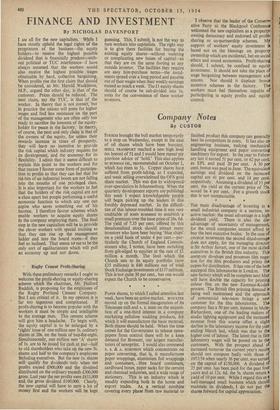Company Notes
By CUSTOS
STRIKES brought the bull market temporarily to a stop on Wednesday, except in the case of oil shares which have been buoyant. SHELL TRANSPORT reached a new high level (ex bonus) of 5i and I would here repeat my previous advice of `hold.' This also applies to BURMAH OIL, recommended on October 1, which has risen to 5f. Copper shares have suffered from profit-taking, as I expected, and weak selling overwhelmed the OFS gold share market. This was clue to widespread' over-speculation in Johannesburg. When the quarterly development reports are published this week I expect knowledgeable people will begin picking up the leaders in this forcibly depressed market. In the difficul- ties of this labour-troubled time it was very creditable of JOHN SUMMERS to establish a small premium over the issue price of 24s. 6d. The yield of 7.35 per cent. offered by this denationalised stock should attract many investors who have been buying `blue chips' on a yield basis of under 4 per cent.—par- ticularly the Church of England Commis- sioners who, I notice, have been switching from gilt-edged to equities at the rate of £1 million a month. The limit which the Church sets to its equity portfolio (now £35 millions) is £40 millions out of total Stock Exchange investments of £137 millions. This is not quite 30 per cent., but one would expect the Church to be conservative.
* PAPER shares, to which I called attention last week, have been an active market. BOWATER moved up on the formal inauguration of its Tennessee mill and A. E. REED on the acquisi- tion of a one-third interest in a company marketing cellulose wadding products, for which it will manufacture the basic material. Both shares should be held. When the time comes for the Government to release news- papers from control there will be a keen demand for Bowater, our largest manufac- turers of newsprint. I would also commend E. S. & A. ROBINSON which concentrates on paper converting, that is, it manufactures paper wrappings, aluminium foil wrappings and containers, fibre board containers, cardboard boxes, paper sacks for the cement and chemical industries, and a wide range of stationery. This is an industry which is steadily expanding both in the home and export trades. As a vertical combine covering every phase from raw material to finished product this company can generally beat its competitors in costs. It has also an engineering business, making mechanical handling equipment and paper converting machinery for export. In the year to Febru- ary last it earned 51 per cent. or 62 per cent. ex EPL and paid 20 per cent. A 50 pet cent. bonus was paid in June. The equivalent earnings and dividend on the increased capital are 41 per cent. and 14 per cent. respectively. Assuming a dividend of 15 pet cent. the yield at the current price of 759. would be 4 per cent. For a growth stock this is not unreasonable.
THE main disadvantage of investing in a small industrial company is a narrow, in- active market: the usual advantage is a high dividend yield. There is also the dis- advantage of uncertainty of management, for the small companies cannot afford to buy the best executive brains. In the case of GEORGE HUMPHRIES the second disadvantage does not apply, for the managing director is Sir Arthur Jarratt, one of the most skilled executives in the British film industry. This company develops and processes film nega- tive for the film producers and prints the copies for distribution. Ithas one of the best equipped film laboratories in London. The new factory which will be complete next May will have double the capacity for printing colour film on the new Eastman-Kodak process. The British film printing demand is being well maintained and the approach of commercial television brings a nevi customer for the film laboratories. The company has a 50 per cent. interest in Mole- Richardson, one of the leading makers of studio lighting equipment and the increased revenue from this source offset a slight decline in the laboratory income for the year ending March last, which was due to the higher cost of labour. The latest rise in film laboratory wages will be passed on to the customers. With the prospect ahead of increased turnover the current year's results should not compare badly with those of 1953/54 when nearly 36 per cent_was earned, on the capital of £150,000. A dividend or 25 per cent. has been paid for the past four years and at 12s. 6d. the 5s. shares return e yield of 10 per cent. While I regard this as A well-managed small business which should maintain its dividends, I do not put the shares forward for capital appreciation.


































 Previous page
Previous page